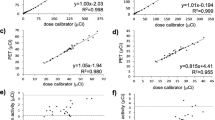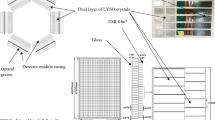Abstract
Purpose
Combined PET/MRI studies receive increasing attention, as their combination allows deeper insight into disease progression. We evaluated a novel 1 T benchtop MRI scanner (1T-MRI) for its use in sequential PET/MRI studies.
Procedures
Phantom studies were performed, addressing the attenuation caused by the MRI coils. For in vivo studies, PET/MRI data acquired with the 1T-MRI were compared with data using a conventional small animal high-field MRI (7T-MRI) in combination with the same PET scanner.
Results
Phantom and in vivo measurements show that the animal beds have no negative impact on the PET scanner performance compared to the 7T-MRI animal bed. Representative images of various animal studies are shown, indicating a wide field for sequential PET-benchtop MRI applications.
Conclusion
Phantom and in vivo data indicate that sequential PET/MRI studies with this novel setup are comparable to sequential PET/MRI studies using a 7T-MRI in combination with a dedicated PET scanner.





Similar content being viewed by others
References
Cherry SR (2004) In vivo molecular and genomic imaging: new challenges for imaging physics. Phys Med Biol 49:R13–R48
Beyer T, Townsend DW, Brun T et al (2000) A combined PET/CT scanner for clinical oncology. J Nucl Med Off Publ Soc Nucl Med 41:1369–1379
Judenhofer MS, Wehrl HF, Newport DF et al (2008) Simultaneous PET–MRI: a new approach for functional and morphological imaging. Nat Med 14:459–465
Delso G, Furst S, Jakoby B et al (2011) Performance measurements of the Siemens mMR integrated whole-body PET/MR scanner. J Nucl Med Off Publ Soc Nucl Med 52:1914–1922
Pichler BJ, Wehrl HF, Judenhofer MS (2008) Latest advances in molecular imaging instrumentation. J Nucl Med Off Publ Soc Nucl Med 49(Suppl 2):5S–23S
Schlemmer HP, Pichler BJ, Schmand M et al (2008) Simultaneous MR/PET imaging of the human brain: feasibility study. Radiology 248:1028–1035
Buscher K, Judenhofer MS, Kuhlmann MT et al (2010) Isochronous assessment of cardiac metabolism and function in mice using hybrid PET/MRI. J Nucl Med Off Publ Soc Nucl Med 51:1277–1284
Zieker D, Konigsrainer I, Weinreich J et al (2010) Phosphoglycerate kinase 1 promoting tumor progression and metastasis in gastric cancer—detected in a tumor mouse model using positron emission tomography/magnetic resonance imaging. Cell Physiol Biochem 26:147–154
Alberini JL, Edeline V, Giraudet AL et al (2011) Single photon emission tomography/computed tomography (SPET/CT) and positron emission tomography/computed tomography (PET/CT) to image cancer. J Surg Oncol 103:602–606
Sauter AW, Wehrl HF, Kolb A et al (2010) Combined PET/MRI: one step further in multimodality imaging. Trends Mol Med 16:508–515
Talbot JN, Fartoux L, Balogova S et al (2010) Detection of hepatocellular carcinoma with PET/CT: a prospective comparison of 18F-fluorocholine and 18F-FDG in patients with cirrhosis or chronic liver disease. J Nucl Med 51:1699–1706
Wissmeyer M, Heinzer S, Majno P et al (2011) Y Time-of-flight PET/MR on a hybrid scanner following liver radioembolisation (SIRT). Eur J Nucl Med Mol Imaging 38:1744–1745
Willekens I, Lahoutte T, Buls N et al (2009) Time-course of contrast enhancement in spleen and liver with Exia 160, Fenestra LC, and VC. Mol Imaging Biol 11:128–135
Constantinescu CC, Mukherjee J (2009) Performance evaluation of an Inveon PET preclinical scanner. Phys Med Biol 54:2885–2899
Mannheim JG, Judenhofer MS, Schmid A et al (2012) Quantification accuracy and partial volume effect in dependence of the attenuation correction of a state-of-the-art small animal PET scanner. Phys Med Biol 57:3981–3993
Kouskoff V, Korganow AS, Duchatelle V et al (1996) Organ-specific disease provoked by systemic autoimmunity. Cell 87:811–822
Matsumoto I, Staub A, Benoist C et al (1999) Arthritis provoked by linked T and B cell recognition of a glycolytic enzyme. Science 286:1732–1735
Kneilling M, Hultner L, Pichler BJ et al (2007) Targeted mast cell silencing protects against joint destruction and angiogenesis in experimental arthritis in mice. Arthritis Rheum 56:1806–1816
Bergers G, Javaherian K, Lo KM et al (1999) Effects of angiogenesis inhibitors on multistage carcinogenesis in mice. Science 284:808–812
Hanahan D (1985) Heritable formation of pancreatic beta-cell tumours in transgenic mice expressing recombinant insulin/simian virus 40 oncogenes. Nature 315:115–122
Muller-Hermelink N, Braumuller H, Pichler B et al (2008) TNFR1 signaling and IFN-gamma signaling determine whether T cells induce tumor dormancy or promote multistage carcinogenesis. Cancer Cell 13:507–518
Schmid A, Braumuller H, Wehrl HF, et al (2011) Non-invasive monitoring of pancreatic tumor progression in the RIP1-Tag2 mouse by magnetic resonance imaging. Mol Imaging Biol. doi:10.1007/s11307-012-0548-0
Kukuk D, Reischl G, Raguin O et al (2011) Assessment of PET tracer uptake in hormone-independent and hormone-dependent xenograft prostate cancer mouse models. J Nucl Med Off Publ Soc Nucl Med 52:1654–1663
Bovens SM, te Boekhorst BC, den Ouden K et al (2011) Evaluation of infarcted murine heart function: comparison of prospectively triggered with self-gated MRI. NMR Biomed 24:307–315
Wehrl HF, Judenhofer MS, Wiehr S et al (2009) Pre-clinical PET/MR: technological advances and new perspectives in biomedical research. Eur J Nucl Med Mol Imaging 36(Suppl 1):S56–S68
Disler DG, McCauley TR, Ratner LM et al (1997) In-phase and out-of-phase MR imaging of bone marrow: prediction of neoplasia based on the detection of coexistent fat and water. AJR Am J Roentgenol 169:1439–1447
Rinck PA, Muller RN (1999) Field strength and dose dependence of contrast enhancement by gadolinium-based MR contrast agents. Eur Radiol 9:998–1004
Besheer A, Caysa H, Metz H et al (2011) Benchtop-MRI for in vivo imaging using a macromolecular contrast agent based on hydroxyethyl starch (HES). Int J Pharm 417:196–203
Caysa H, Metz H, Mader K et al (2011) Application of benchtop-magnetic resonance imaging in a nude mouse tumor model. J Exp Clin Cancer Res 30:69
Kempe S, Metz H, Pereira PG et al (2010) Non-invasive in vivo evaluation of in situ forming PLGA implants by benchtop magnetic resonance imaging (BT-MRI) and EPR spectroscopy. Eur J Pharm Biopharm 74:102–108
Acknowledgments
This work was funded by the German Ministry for Education and Research (BMBF) (MoBiMed, grant 01EZ0810), by the Deutsche Forschungsgemeinschaft (DFG) (SFB 685, SFB 773, INST 2388/21-1 FUGG, and KFO 274), Innovative Medicine Initiative Joint Undertaking under grant agreement 115001 (MARCAR), and by a grant from the Ministry of Science, Research and the Arts of Baden–Württemberg (Az:32-7462.1-UK/7/2).
We also acknowledge the support of Bruker BioSpin MRI GmbH, specifically to Dr. Oerther and Dr. Treiber. We also would like to thank Maren Koenig, Daniel Bukala, and Funda Cay for excellent technical support. [18F]FDG was kindly provided by the Radiopharmacy Tübingen, Anke Stahlschmidt.
Conflict of Interest Statement
We do not have any conflicts of interest to report.
Author information
Authors and Affiliations
Corresponding author
Electronic Supplementary Material
Below is the link to the electronic supplementary material.
ESM 1
(PDF 457 kb)
Rights and permissions
About this article
Cite this article
Schmid, A., Schmitz, J., Mannheim, J.G. et al. Feasibility of Sequential PET/MRI Using a State-of-the-Art Small Animal PET and a 1 T Benchtop MRI. Mol Imaging Biol 15, 155–165 (2013). https://doi.org/10.1007/s11307-012-0577-8
Published:
Issue Date:
DOI: https://doi.org/10.1007/s11307-012-0577-8




